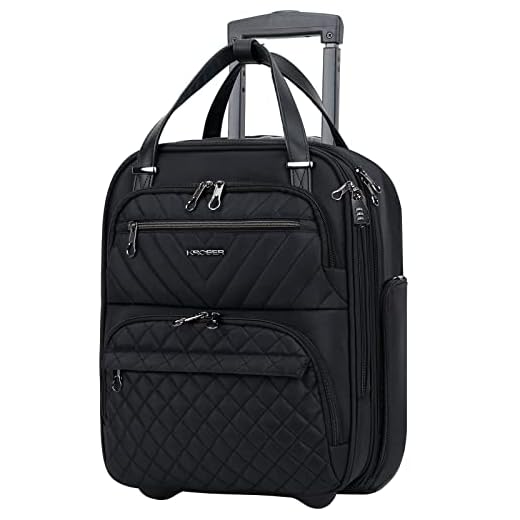



Maximum permissible size is typically 158 cm (62 inches) when you combine length, width, and height. This standard applies to checked items, necessitating adherence to airline-specific policies that can vary significantly.
Handheld cases generally should not exceed 55 cm x 40 cm x 20 cm (21 in x 15 in x 7 in). Some carriers offer more generous allowances; however, always verify the precise limits applicable to your chosen airline.
Weight restrictions are equally crucial. Many airlines cap the weight of checked items around 23 kg (50 lbs) per piece, while cabin bags often have a limit of 7 kg (15 lbs). Surpassing these limits may incur additional fees, so weighing your possessions beforehand is wise.
Review baggage regulations ahead of departure to avoid delays or unexpected charges. Understanding these guidelines can greatly ease the boarding process and enhance your overall experience.
Understanding Airline Size Restrictions for Carry-On Bags
Each airline mandates specific measurements for carry-on items, typically ranging from 20 to 22 inches in height, 14 to 16 inches in width, and 8 to 10 inches in depth. It’s critical to check your airline’s website before packing, as some carriers have stricter rules than others.
Variability Among Carriers
Budget airlines often impose tighter restrictions compared to major carriers. For example, Ryanair allows a maximum size of 15.7 x 7.9 x 19.7 inches, while Delta permits up to 22 x 14 x 9 inches. Always verify dimensions in advance, as exceeding the limit can result in hefty fees or having to check your bag.
Weight Limits and Additional Fees
In addition to size, weight limitations are common. Many airlines cap carry-on weight between 15 to 25 pounds. Certain low-cost carriers charge extra for overweight items or may require you to check it in. Familiarize yourself with these details to avoid unexpected charges.
Determining Checked Baggage Dimensions Based on Destination
Check the regulations specific to your destination, as many countries have distinct constraints for checked items. For example, flights to Europe often allow a maximum weight of 23 kg (50 lbs) per bag, while some Asian airlines may permit only 20 kg (44 lbs).
Regional Variations
North American carriers generally follow a size standard of 158 cm (62 inches) in total linear dimensions. In contrast, carriers in South America might enforce stricter regulations, limiting total size to 157 cm (61.8 inches). Always verify with the airline before packing.
Airline-Specific Policies
Major airlines like Emirates and Qatar Airways frequently impose enhanced dimensions or weight rules, including special regulations for specific destinations. Plan ahead by visiting the airline’s official website or customer service for precise information.
Variations in Baggage Allowances Among Major Airlines
Each airline has specific constraints regarding baggage size and weight, which can greatly differ from one to the next. For instance, American Airlines typically permits a carry-on measuring up to 22 x 14 x 9 inches, while Lufthansa allows 21.7 x 15.7 x 9 inches. These small differences can have significant implications for travelers, particularly for those packing meticulously for their trips.
Checked Baggage Regulations
Checked items often encounter similar discrepancies. Delta Airlines allows bags up to 62 linear inches (length + width + height), while British Airways enforces a slightly smaller allowance of 56 linear inches. Weight limits also vary; for example, Air France limits checked baggage to 50 lbs, while Emirates permits up to 70 lbs for premium passengers. Not checking the specific airline guidelines can result in unexpected fees.
Additional Considerations
Frequent travelers should keep in mind that some airlines offer more lenient allowances for elite members or during specific promotional periods. Always verify current regulations on the airline’s website to avoid surprises. Moreover, consider purchasing travel gear designed for compliance, much like selecting the best cantilever patio umbrella for wind to ensure it withstands varying conditions.
Travelers should also check for items such as sports equipment or musical instruments; these can have unique requirements. The need to understand these aspects is crucial, similar to knowing which organelle is responsible for protein synthesis when studying biology.
Tips for Measuring and Packing Within Allowed Dimensions
Utilize a soft measuring tape to ensure accurate readings of your bag’s length, width, and height. Unlike rigid measuring tools, a soft tape conforms to the bag’s edges, providing precise dimensions.
Before finalizing your packing, place your suitcase on a flat surface and check its measurements against airline requirements. Include any wheels or handles in your assessment, as these elements can impact overall size.
To maximize space:
- Roll clothing instead of folding to save room and minimize wrinkles.
- Stuff shoes with socks or smaller items to optimize every nook.
- Utilize compression bags for garments to reduce volume.
Use packing cubes to keep items organized and easily accessible while maintaining compliance with size restrictions.
Weigh your packed item with a reliable scale before departure to avoid surprises at check-in. Remember that excess weight can lead to additional fees.
Consider your destination’s climate while choosing your wardrobe. Pack versatile clothing that can be layered, which allows for less bulk without sacrificing comfort.
Check if the airline offers a specific template for sizing at the airport, often available near the check-in counters, to ensure compliance.
Lastly, review the airline’s policies a few days before your flight, as they may change. Keeping abreast of these details can avoid last-minute issues at the airport.







